Raul Fattore
May 27, 2024
This study is divided into four parts
Table of Contents
Summary of Part 1
The neutron, which is a bound proton-electron, contributes to electricity generation. Radiation emitted by nuclei and single charges can also generate electric energy. There is no nuclear strong or weak force, only an electrodynamic force. The example of protons fusion demonstrates that the Universal Force provides precise information about interactions without empirical approximations. The radiation power increases to theoretical infinity as the relative velocity approaches the speed of light.
Abstract
The increasing need for energy by mankind over time has led to climate change problems and, most importantly, human health issues due to the storage of radioactive waste that lasts a very long time, thus affecting future generations.
Advances in atomic and nuclear physics several years ago promised a revolution in energy production, offering a significant advantage over burning coal, gas, or oil. Unfortunately, scientists at that time did not make use of their brains appropriately. They simply misused and wasted all the advanced knowledge acquired in atomic and nuclear physics to just boil water!
Nuclear fusion was “reborn” as an alternative to generate energy that might be “clean” for the environment, with “minimum” radiation risks for mankind and no radioactive waste. Clean energy generation and radiation-free risks can only be guaranteed by using certain technology for nuclear fusion.
Making a fusion reaction happen is not complicated (like 14-year-old Taylor Wilson did in his home in 2008). However, there are two main problems with nuclear fusion that have prevented it from being commercially viable until now:
- Efficiency
- Safety
Currently, most scientists experimenting with nuclear fusion are making serious mistakes. They are using costly devices and wasting vast amounts of energy in an attempt to replicate conditions found in stars on Earth, with no encouraging outcomes to date. Why? Fusions in stars are processes that are fully determined by probability, so you cannot build a project just on them. Probability is not the same as certainty, even when it represents the likelihood that an event will occur.
Negative mass calculations can provide certainty regarding an effective head-on collision of charges, but scattering cross-section calculations cannot.
Nuclear fusion can be greatly eased by negative mass. I refer the reader to the series of articles about Negative Mass in Atom Nuclei [1] to understand how we can have negative mass behavior in nuclei.
- Is nuclear fusion enhanced with negative mass nuclei and particles?
- Can negative mass nuclear fusion be made efficient?
- Can negative mass nuclear fusion offer better safety?
- Does negative mass nuclear fusion rely on statistical processes?
- Does negative mass nuclear fusion offer a simpler and cheaper method to generate energy?
In the development of this study, you’ll find comprehensible answers to the above questions, which are backed by the experimentally proven laws of electrodynamics through the Universal Electrodynamic Force and the New Atomic Model.
Introduction
Nuclear fusion is an extremely fast and violent event that involves the acceleration of charges, whether they are nuclei or single charges. Therefore, scientists should not lose sight of the fact that in any atomic and nuclear interaction, we are dealing with accelerated electric charges.
As such, radiation is always present in any nuclear fusion reaction. No exception.
Due to the huge acceleration of the charges, the spectrum may easily range from X-rays to the most powerful gamma radiation. This radiation can be used in our favor to generate electric energy [9]. However, if this radiation is not properly handled, it will be harmful for human health.
For simplicity, the radiation symbols will be omitted in most of the reaction calculations throughout this study. However, as radiation is always present in any nuclear fusion, from X-ray to gamma, the right way to write a reaction should be to include the radiation symbols as part of the fusion products: A+B\ \rightarrow\ C+D\ +\ \left(X,\ \gamma\right).
Unfortunately, scientists are making deficient calculations of the released energy during nuclear fusion. Why?
Because they use wrong formulas that don’t give the total energy of the system, like the known Einstein’s formula E=\Delta m\ c^2 for mass excess/defect calculations. This formula only gives a result for rest mass energy (potential energy), which should be equivalent to the acquired kinetic energy, but it gives no clues about acceleration. The Einstein energy formula is flawed even in its “relativistic” form since, as in classical mechanics, acceleration is entirely disregarded.
The total energy in a fusion reaction is always higher than the results given by Einstein’s formulas for rest energy and the calculations of kinetic energy from classical mechanics.
Most of the energy values for nuclear fusion given in the scientific literature are deficient because none of them consider radiation energy, which on occasion may be much higher than kinetic energy alone.
Applying Einstein’s formulas and classical mechanics’ kinetic energy calculations to nuclear fusion is extremely risky, since you can never be certain of the amount of radiation generated during a reaction.
The scientific community must be aware when using those formulas because:
• They only give partial energy values.
• They are not compatible with a system of charges.
Those formulas may only be applied to limited, simple mechanical interactions between uncharged bodies.
The derivation of the total energy for a system of charges made in this study will provide scientists with a powerful formula to make real energy calculations in any nuclear fusion reaction and many other applications that involve the interaction of charges.

Charge density of the proton and neutron
There are no “neutral particles”. The so-called “neutral particles” are composed of charges that balance the net result [2]. An example of such a particle is the neutron.
Neutrons are stable in the nucleus. However, outside the nucleus, the neutron decays into a proton and an electron with a half-life of fewer than 15 minutes. The mass of the neutron is the sum of the masses of the electron and proton. The neutron has a charge density that varies between positive and negative with respect to its radius (Fig. 1). These facts suggest that the neutron might not be a valid elementary particle but a bound combination of an electron and a proton [3].
Accordingly, the new atomic model precisely describes how electrons and protons are very tightly packed in shells in the nucleus due to the balance of electromagnetic forces.
Based on the energy calculations I made for the Deuterium-Tritium fusion, the binding energy (potential energy) of the electron-proton pair that makes the neutron should be E=-2.127\ MeV when in the nucleus. Outside the nucleus, this energy is given off (radiation, kinetic) during neutron decay time, which unbinds the electron-proton pair.
Because the neutron is always regarded as a “neutral” particle, scientists’ calculations of nuclear reactions and stray reactions may only be partially accurate. The electron and proton may take part in reactions with nuclei or with other electrons and protons when the electron-proton pair that built the neutron unbinds. While some of these reactions will produce energy, others may use some of the system’s energy to generate the fuel for fusion.
As far as I know, these “additional” reactions were never mentioned in any scientific paper. However, some of them could be of such importance that they cannot be ignored and must be considered in calculations, as will be demonstrated in the development of this study.
Since the neutron is one of the fusion products in several reactions and usually carries a high level of kinetic energy and radiation energy, we might be able to use these facts and the internal structure of the neutron in our favor.
The fact that the neutron is a composite of two charges means that we may expect a radiation spectrum from X-rays to gamma rays when the particle is in positive or negative accelerated motion. This is additional energy that we may harvest from the “neutron”, which can be converted into electricity, besides the charges themselves.
The Laws of Electrodynamics are Valid on Any Scale
There is no reason for the laws of electrodynamics not to be valid at atomic scales.
No such thing as “Nuclear Strong Force” or “Nuclear Weak Force” exists as proposed by Quantum Theory. We have only one force in Mother Nature that is valid on any scale: the Universal Electrodynamic Force [1]. It can clearly explain atomic and nuclear interactions without any need to create any new forces, as Quantum Theory did.
The Universal Electrodynamic Force
Lucas’ universal electrodynamic force in vectorial form is:

(1)
Where \vec{\beta}=\frac{\vec{v}}{c}, and \vec{r},\ \vec{v},\ \vec{a}, are the relative position, velocity, and acceleration between the two charges.
In general, velocity and acceleration may not have the same direction. Let’s define their angles with respect to the vector \vec{r}.
\theta: angle between \vec{r} and \vec{v}
\alpha: angle between \vec{r} and \vec{a}
Then, we can write the universal force in geometrical form:

(2)
Force in the Fusion of Two Protons
Assuming a head-on collision condition for the two protons (\theta=\alpha=\pi ), the Universal Force in this case becomes:
F_u=\frac{k\cdot q_1\cdot q_2\cdot\left(\left(1-\frac{v^2}{c^2}\right)\cdot r-\frac{2\cdot r^2\cdot a}{c^2}\right)}{r^3}-\frac{k\cdot q_1\cdot q_2\cdot\left(1-\frac{v^2}{c^2}\right)\cdot\left(\left(\frac{v^2\cdot r^2}{c^2}-\frac{r^3\cdot a}{c^2}\right)\cdot r-\frac{v^2\cdot r^3}{c^2}+\frac{r^4\cdot a}{c^2}\right)}{r^5} (3)
Suppose that the protons come together to “fuse” at a distance equal to their radii r={0.85\ 10}^{-15}m. The graph of the force vs. velocity and acceleration (Fig. 2) shows us how the force changes in magnitude and sign according to the kinetics of the charges:
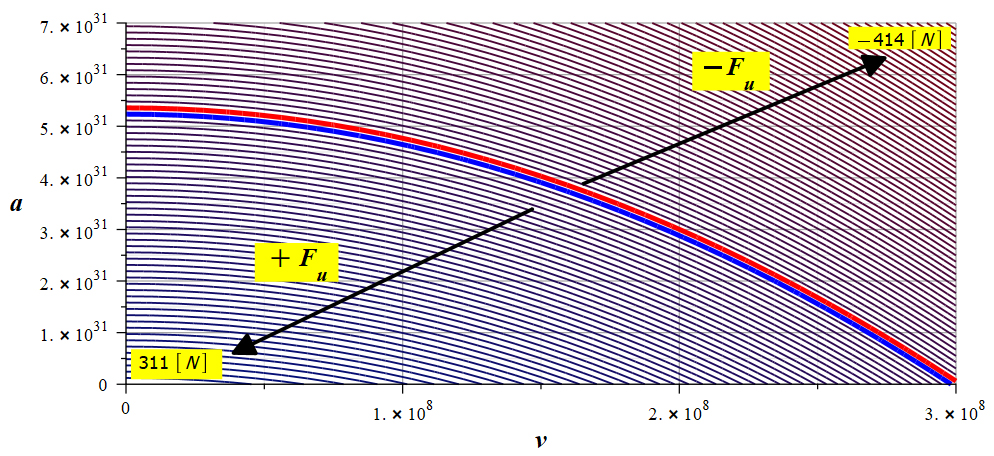
Force in the fusion of two protons
The thick blue and red lines delimit the region of zero force. The force between the two protons at some distances is negative for certain combinations of relative velocity and acceleration. For low relative velocities, the acceleration must be huge for a negative force. On the other hand, for low relative acceleration, the velocity must be huge.
How does the force change with the relative distance under such conditions?
The graph in Fig. 3 corresponds to the following values of relative velocity and acceleration: v=10\frac{m}{s} and a=5\ {10}^{31}\frac{m}{s^2}.
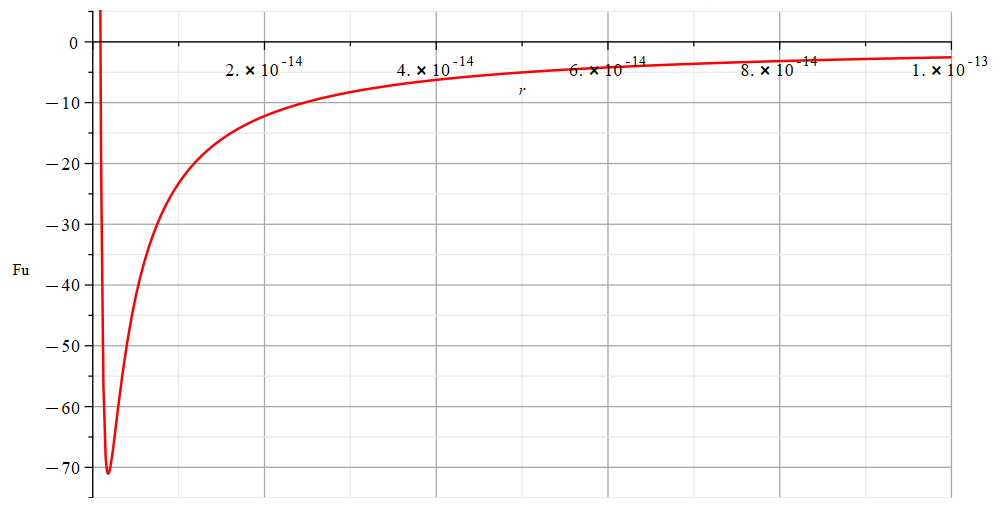
Force vs. distance in the fusion of two protons
By calculating the zero-force point, we’ll see that it happens at the following distance:
r_0=\frac{c^2\left(1-\frac{v^2}{c^2}\right)}{2a} (4)
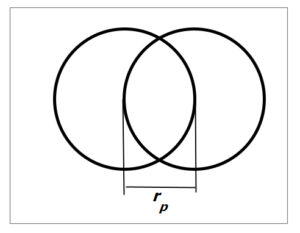
Zero force distance in the fusion of two protons
This distance is the point of minimum energy. For the given velocity and acceleration above, r_0=0.9\ {10}^{-15}m, which means that this happens when both charges overlap (approximately) by their radii, as shown in Fig. 4.
On the other hand, the minimum of the function or the maximum negative force point can be found by taking the derivative of the force equal to zero \frac{d}{dr}\left(F_u\right)=0, which gives as a result:
{r_F}_{max}=\frac{c^2\left(1-\frac{v^2}{c^2}\right)}{a} (5)
We see that this point is the double of the distance for the zero-force point, i.e., {r_F}_{max}=1.8\ {10}^{-15}m.
A Brief Analysis of the Terms of the Universal Electrodynamic Force
Analyzing the significance of the terms in the Universal Force will give us a better understanding of the forces, energies, and momenta that develop in nuclear fusion reactions.
First term of the Universal Force: static and velocity electric fields
This term accounts for the static and velocity electric fields.
{\vec{F}}_1=\frac{q_1\cdot q_2}{4\cdot\pi\cdot\varepsilon_0r^2}\cdot\frac{1\hat{r}}{\left(1-\beta^2\cdot\sin^2{\left(\theta\right)}\right)^\frac{1}{2}}-\frac{q_1\cdot q_2}{4\cdot\pi\cdot\varepsilon_0r^2}\cdot\frac{\beta^2\hat{r}}{\left(1-\beta^2\cdot\sin^2{\left(\theta\right)}\right)^\frac{1}{2}} (6)
We can write this term as:
{\vec{F}}_{E0}+{\vec{F}}_{Ev}=q_2({\vec{E}}_0-{\vec{E}}_v) (7)
For rectilinear motion, \theta=0\ or\ \pi:
{\vec{F}}_1=\frac{q_1\cdot q_2}{4\cdot\pi\cdot\varepsilon_0r^2}\hat{r}-\frac{q_1\cdot q_2}{4\cdot\pi\cdot\varepsilon_0r^2}\cdot\beta^2\hat{r} (8)
For circular motion, \theta=\frac{\pi}{2}\ or\ \frac{3\pi}{2}:
{\vec{F}}_1=\frac{q_1q{2\sqrt{1-\beta^2}}}{4\pi\varepsilon_0r^2}\hat{r} (9)
In both types of motion (8) and (9), if v<<c, then the term reduces to the classic Coulomb static force term. However, if v\rightarrow\ c, then {\vec{F}}_1\rightarrow0, i.e., the force term vanishes in both motions.
Second term of the Universal Force: radiation in any accelerated motion
This term is an acceleration electric field that contributes to the radiation in the same direction as the acceleration, making it valid for any motion.
{\vec{F}}_2={\vec{F}}_{Ea}=\frac{q_1\cdot q_2}{4\cdot\pi\cdot\varepsilon_0rc^2}\cdot\frac{2\vec{a}}{\left(1-\beta^2\cdot\sin^2{\left(\theta\right)}\right)^\frac{1}{2}} (10)
Third term of the Universal Force: perpendicular and longitudinal magnetic forces
This term is the sum of the magnetic forces in the direction of \vec{r} and \vec{v}.
{\vec{F}}_3=-\frac{q_1\cdot q_2}{4\cdot\pi\cdot\varepsilon_0r^3}\cdot\frac{\left(1-\beta^2\right)\cdot\beta^2\cos^2{\left(\theta\right)}\vec{r}}{\left(1-\beta^2\cdot\sin^2{\left(\theta\right)}\right)^\frac{3}{2}}+\frac{q_1\cdot q_2}{4\cdot\pi\cdot\varepsilon_0r^2}\cdot\frac{\left(1-\beta^2\right)\cdot\beta\cos{\left(\theta\right)}\vec{\beta}}{\left(1-\beta^2\cdot\sin^2{\left(\theta\right)}\right)^\frac{3}{2}} (11)
Ampere’s law only includes the distance direction term (\hat{r}) of the magnetic force between the two charges. However, as experimentally demonstrated by Graneau [4], there is also a magnetic force in the direction of the current (“longitudinal” magnetic force). The second term of the magnetic force in the direction of \vec{v} is a proof of that force.
We may rewrite this term as a magnetic force as follows: {\vec{F}}_3={\vec{F}}_{Br}+{\vec{F}}_{Bv}=q_2v\left[{\vec{B}}_r+{\vec{B}}_v\right] (12)
The first term of the magnetic force is the classic Ampere magnetic field force between two moving charges. Note that \gamma=(1-\beta^2):
{\vec{F}}_{Br}=-q_2v\cdot\left[\frac{q_1}{4\cdot\pi\cdot\varepsilon_0r^3}\cdot\frac{\gamma\cdot\frac{v}{c^2}\cos^2{\left(\theta\right)}r\hat{r}}{\left(1-\beta^2\cdot\sin^2{\left(\theta\right)}\right)^\frac{3}{2}}\right] (13)
The second term of the magnetic force is the velocity magnetic field force, or the “longitudinal” Ampere force:
{\vec{F}}_{Bv}=q_2v\cdot\left[\frac{q_1}{4\cdot\pi\cdot\varepsilon_0r^2}\cdot\frac{\gamma\cdot\frac{1}{c}\cos{\left(\theta\right)}\vec{\beta}}{\left(1-\beta^2\cdot\sin^2{\left(\theta\right)}\right)^\frac{3}{2}}\right] (14)
Independent of the relative velocity \vec{v}, the magnetic force term {\vec{F}}_3 will always vanish when \vec{v} is in the direction of \vec{r} (\theta=0,\ \pi ), or for 90^{\circ} as in Circular Motion.
Fourth term of the Universal Force: radiation in non-linear accelerated motion (Bremsstrahlung)
This radiation force has two components: one in the direction of \vec{r} and the other in the direction of \vec{a}. When both vectors are in the same direction (like in linear motion) or opposite direction (like in opposite linear motion and uniform circular motion), then this radiation force is zero.
This term contributes, in general, to the radiation force for non-linear accelerated motion. It is zero for linear accelerated motion and uniform circular motion, but non-zero otherwise. It is the so-called Bremsstrahlung, which also includes synchrotron radiation, cyclotron radiation, etc.
{\vec{F}}_4=-\frac{q_1\cdot q_2}{4\cdot\pi\cdot\varepsilon_0r^2c^2}\cdot\frac{\left(1-\beta^2\right)\cos{\left(\alpha\right)}a\vec{r}}{\left(1-\beta^2\cdot\sin^2{\left(\theta\right)}\right)^\frac{3}{2}}+\frac{q_1\cdot q_2}{4\cdot\pi\cdot\varepsilon_0r^2c^2}\cdot\frac{r\left(1-\beta^2\right)\vec{a}}{\left(1-\beta^2\cdot\sin^2{\left(\theta\right)}\right)^\frac{3}{2}} (15)
In short form:
{\vec{F}}_{Rad}=q_2{\vec{E}}_{Rad} (16)
After the brief analysis of terms of the Universal Electrodynamic Force, we see that there are two terms contributing to the radiation force, namely the second and fourth terms, each valid for a certain type of motion. The full radiation force valid for any accelerated motion is given by the addition of those two terms: {\vec{F}}_{rad}={\vec{F}}_4+{\vec{F}}_2.
Then, the full radiation force valid for any motion is:
{\vec{F}}_{rad}=\frac{q_1q_2}{4\pi\varepsilon_0r^2c^2\left(1-\beta^2\cdot\sin^2{\left(\theta\right)}\right)^\frac{3}{2}}\cdot\left(-\frac{rv}{c^2}\left(2\sin^2{\left(\theta\right)}+1\right)v\vec{a}+3r\vec{a}-a\cos{\left(\alpha\right)}r\hat{r}+\frac{rv}{c^2}\cos{\left(\alpha\right)}va\hat{r}\right) (17)
Calculation of the Radiation Power
The rate of energy per unit area, power per unit area, or intensity is given by the Poynting vector. The energy flow per unit time per unit area is: S=\frac{1}{dA}\frac{dU}{dt}=\varepsilon_0c\cdot|{\vec{E}}_{rad}|^2\ \ \ \ \ \left[\frac{W}{m^2}\right]
The area described by a solid angle is dA=r^2d\Omega, where d\Omega=\sin{\left(\theta\right)}d\theta d\phi. Replacing dA in the Poynting formula: S=\frac{1}{r^2d\Omega}\frac{dU}{dt}. So, the power radiated per solid angle is: dP_{sr}=\frac{dU}{dtd\Omega}=Sr^2, where dP_{sr} is the power per steradian. The total energy flow per unit time (power, P) radiated into all angles out of any closed surface, is the integral over the surface:
P=\frac{dU}{dt}=\int\int{dP_{sr}}d\Omega=\int_{0}^{2\pi}{\int_{0}^{\pi}Sr^2\sin{\left(\theta\right)}d\theta}d\phi (18)
Examples of calculations of the radiation power derived for some typical motions are shown in the tables below. The first two tables* show the results of the single radiation terms (the second and fourth terms of the Universal Force). The last table* shows the results of the total radiation force (Eq. 17), which is given by the addition of the second and fourth radiation terms.
* Remember that \beta=\frac{v}{c}.
Radiation power corresponding to the second term only:
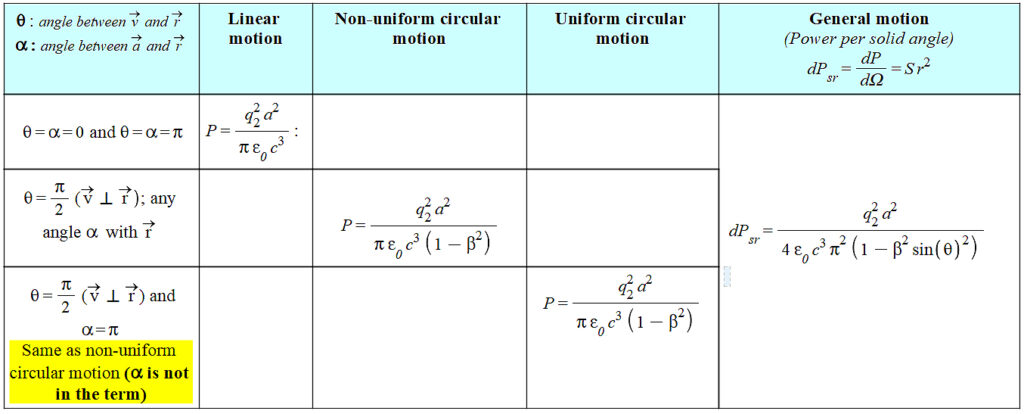
Radiation power from the second term of the Universal Force
Radiation power corresponding to the fourth term only:

Radiation power from the fourth term of the Universal Force
Radiation power corresponding to the full radiation force term {\vec{F}}_{rad}, valid for any motion:
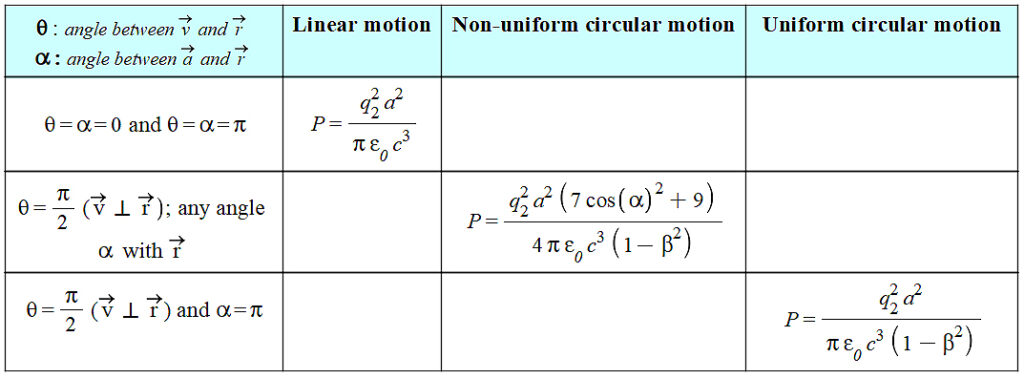
Radiation power from the full radiation force term of the Universal Force
By looking at the results from Fig. 7, we see that the only case where the radiation power depends only on the relative acceleration is for linear motion. For any other type of motion, the radiation power depends on both the relative acceleration and the relative velocity. For a given constant acceleration, when v\rightarrow\ c, the radiation power tends to infinity, P\rightarrow\infty.
Conclusions
It was demonstrated that the neutron is not a legitimate particle but a bound between a proton and an electron. As such, these two charges are proposed to contribute to the generation of electricity.
It was proposed that the radiation emitted by the nuclei and single charges could also be used to generate electric energy.
There is no “Nuclear Strong Force” or “Nuclear Weak Force”. The only force governing the interaction between bodies on any scale is purely an electrodynamic force.
The example of the fusion of two protons demonstrates to us how the Universal Force gives us precise information about the interaction without any need for empirical approximations.
The brief analysis of the terms of the Universal Electrodynamic Force brought into light the important fact that the radiation power increases to very high values (theoretically \infty) as the relative velocity approaches the speed of light.
Bibliography
[1]. Raul Fattore, “Negative Mass and Negative Refractive Index in Atom Nuclei – Nuclear Wave Equation – Gravitational and Inertial Control” (2023), Part-1, Part-2, Part-3, Part-4, Part-5, Part-6
[2]. Raul Fattore, “What is Charge? – The Redefinition of Atom – Energy to Matter Conversion” (2023), https://physics-answers.com/what-is-charge-the-redefinition-of-atom-energy-to-matter-conversion/
[3]. David L. Bergman, “Shape & Size of Electron, Proton & Neutron” (2004), Foundations of Science
[4]. N. Graneau, T. Phipps Jr, and D. Roscoe, “An experimental confirmation of longitudinal electrodynamic forces” (2001), The European Physical Journal, https://www.researchgate.net/publication/225353333_An_experimental_confirmation_of_longitudinal_electrodynamic_forces
[5]. V. Milián-Sánchez, F. Scholkmann, et al., “Fluctuations in measured radioactive decay rates inside a modified Faraday cage: Correlations with space weather” (2020), Nature, https://www.nature.com/articles/s41598-020-64497-0
[6]. J.M. Mack, et al., “Remarks on detecting high-energy deuterium–tritium fusion gamma rays using a gas Cherenkov detector” (2006), Los Alamos National Laboratory, Lawrence Livermore National Laboratory, https://www.sciencedirect.com/science/article/abs/pii/S0969806X05003683
[7]. G.R. Mackenzie, et al., “A diamond gammavoltaic cell utilizing surface conductivity and its response to different photon interaction mechanisms” (2021), School of Physics, University of Bristol, https://www.sciencedirect.com/science/article/abs/pii/S2468606921000538
[8]. M. G. Spencer, T. Alam, “High power direct energy conversion by nuclear batteries” (2019), Applied Physics Reviews. 6. 031305. 10.1063/1.5123163, https://www.researchgate.net/publication/335809562_High_power_direct_energy_conversion_by_nuclear_batteries
[9]. K. Hashizume, et al., “Direct Energy Conversion from Gamma Ray to Electricity Using Silicon Semiconductor Cells” (2010), MRS Online Proceeding Library Archive. 1264. 1264-BB05. 10.1557/PROC-1264-BB05-01, https://www.researchgate.net/publication/330650579_Direct_Energy_Conversion_From_Gamma_Ray_to_Electricity_Using_Silicon_Semiconductor_Cells
[10]. Nie Luo, et al., “Proton bremsstrahlung and its radiation effects in fusion reactors” (2010), Department of Nuclear, Plasma and Radiological Engineeing, Univerisity of Illinois, https://www.sciencedirect.com/science/article/abs/pii/S0920379609002440
[11]. INTERNATIONAL ATOMIC ENERGY AGENCY, Fusion Physics, Non-serial Publications, IAEA, Vienna (2012), https://www.iaea.org/publications/8879/fusion-physics
Related articles:
Nuclear Fusion Enhanced by Negative Mass – A Proposed Method and Device – (Part 2)
Nuclear Fusion Enhanced by Negative Mass – A Proposed Method and Device – (Part 3)
Nuclear Fusion Enhanced by Negative Mass – A Proposed Method and Device – (Part 4)
What is Charge? – The Redefinition of Atom – Energy to Matter Conversion
Charge Radiation Derived from the Universal Electrodynamic Force – Proof of the Cherenkov Effect
Faster-Than-Light Travel Feasible with Negative Mass – Superluminal Dynamics
New Atomic Model with Real-Valued Wave Function – Energy Levels, Spectrum, and Atomic Fine Structure
